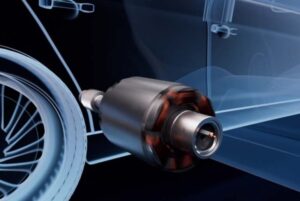ZF has recently developed a magnet-free electric motor disparate to separately excited synchronous motors.
 The motor is compact with maximum power and torque density as ZF’s I2SM (In-Rotor Inductive-Excited Synchronous Motor) transmits the energy for the magnetic field via an inductive exciter inside the rotor shaft.
The motor is compact with maximum power and torque density as ZF’s I2SM (In-Rotor Inductive-Excited Synchronous Motor) transmits the energy for the magnetic field via an inductive exciter inside the rotor shaft.
This advanced variant of a separately excited synchronous motor is thus an alternative to permanent-magnet synchronous machines (PSM). The latter are currently the motors most frequently used in electric vehicles, but they are based on magnets which require rare earth materials for their production.
“With this magnet-free e-motor without rare earth materials, we have another innovation with which we are consistently improving our electric drive portfolio to create even more sustainable, efficient, and resource-saving mobility,” said Dr. Holger Klein, CEO of ZF. “This is our guiding principle for all new products. And we currently see no competitor that masters this technology as well as ZF.” Compared to common SESM systems, the inductive exciter can reduce losses for the energy transmission into the rotor by 15 percent. In addition, the CO2 footprint in production, which arises with PSM e-motors in particular due to magnets including rare earth materials, can be reduced by up to 50 percent.
In addition to the benefits of eliminating rare earth materials in a compact and powerful package, the I2SM eliminates the drag losses created in traditional PSM e-motors. This enables better efficiency at certain operating points such as long highway trips at high speed.
To ensure that the magnetic field in the rotor is built up by current instead of magnets, the conventional SESM concepts currently still require sliding or brush elements in most cases, which force compromises: A dry installation space, i.e. not accessible for oil cooling and with additional seals, is necessary. As a result, conventional SESMs take up around 90 mm more space axially. As a result, manufacturers generally cannot flexibly vary between PSM and SESM variants in their model planning without additional effort.
The technological prerequisite for the ZF innovation is that energy is transferred inductively, i.e., without mechanical contact, into the rotor, generating a magnetic field by means of coils.
